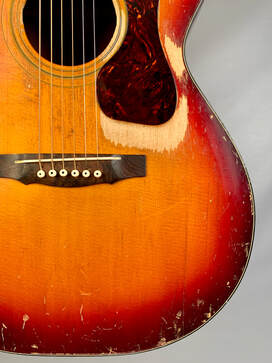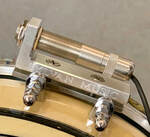 Some people like to keep their instruments looking as new and pristine as possible, I am not one of these people. Sure, I protect my guitars, keep them safe, and clean them when they’re dirty, but I welcome any scratches or playwear they sustain in their honest work. I’ve always seen wear on an instrument as a badge of honor, a kind of battle scar, and I always assume that any well played instrument can’t help but gather some, if not many, in their long life. As the buyer for this shop, I always get excited when someone wants to sell us something old and it looks, as my buddy Ed likes to say, ‘like it’s been rode hard and put away wet.’ Usually, that means this instrument is going to sound great! This is obviously not always the case, but more often than not it is. On this flip side, I’m always wary of an instrument that is decades old but has barely any scratches on it. Sure that may be nice for a collector who just wants to stick it in a glass case and look at it from time to time, but it probably sounds stiff and sterile. Not my cup of tea personally. So don’t hold back when you wanna do some heavy strumming on your favorite axe. There’s a time and a place for light, sensitive strumming and fingerpicking, but sometimes you just gotta let it rip. And if you scratch up your ‘baby,’ don’t worry, it probably won't be the last time. Think of each scratch or mark as adding to the character and tone of your instrument. Welcome them. Invite them. Cherish them. It’s all part of this magical journey of creating music. - Mike
48 Comments
We live in the golden age of guitar building. The available knowledge regarding guitar craftsmanship, the array of skilled manufacturers of all sorts and the world-wide demand for unique, personalized instruments is at an all time high. There's never been more variety in the market place when it comes to different options available to the consumer. From the thousands of different guitar pickups, tone woods, finish options, neck profile shapes, fret wire size to the various component values of guitar electronics... yikes! The options may seem overwhelming. When you're in the market for a guitar, it can be tough to distinguish how impactful any of these variables may be to you as the player. Let's break it down and take a look at three basic features to consider when evaluating a guitar: scale length, nut width and bridge spacing.
Scale length (or the measurement from the nut to the saddle) has a big impact on the feel, response and sound of the guitar. A shorter scale length like Gibson's 24.75" will have a looser feel, producing a warmer, more mellow tone whereas a longer scale length like Fender's 25.5" scale length has a tighter response with a brighter, snappier sound. Of course, a shorter scale length means the frets are closer together, which can make fretting chords more comfortable. The additional tension of a longer scale length can create louder projection, something to consider if you're looking for the next 'banjo killer' dreadnought. Nut width and bridge spacing really have to do with the physical comfort of the guitar more than impacting the sound of the instrument. As much as jumbo acoustics may feel cumbersome for smaller guitar players, you may consider a different nut width depending on the size of your hands. Players with large hands may prefer a wider nut width. A narrower a nut width means the strings are closer together, making intricate chord fingerings more challenging for larger hands but just right for players with smaller paws. Maybe you wrap your fretting hand thumb around the neck to fret the low E string, playing psychedelic RnB a la Jimi Hendrix or the thumbpicking style of Merle Travis? Both of these artists preferred a narrower nut width to facilitate their styles. Are you more of a fingerstyle player? You may find wider bridge spacing more comfortable for your picking hand. While these suggestions may serve as a general guide, these guitar measurements are really about your personal preference. Pick up your favorite guitar and consider its scale length, nut width and bridge spacing. What about that guitar really appeals to you? Is it comfortable? Maybe there's something about it that you wish were different. Go to your local guitar shop and play some instruments while keeping in mind these various options. If the exact combination of features isn't available on a guitar in your local shop, it's very possible one can be custom made to suit your preferences. Many boutique acoustic guitar makers such as Santa Cruz Guitar Co, Lowden and Goodall offer different scale lengths, nut widths and bridge spacings as custom options on their instruments. Good luck and happy strumming! - Gerard When I started working at Sylvan there were many things I looked forward to: meeting musicians, playing guitars I’d seen in my dreams, stretching and challenging myself in the world of guitar repair, and, of course, the ability to tell people that I work at the world renowned Sylvan Music.
I never foresaw what became one of, if not the most, satisfying parts of my job: the cleaning of a dead-skin packed, oiled ridden and dirt covered fret board! There is nothing like taking a fresh razor blade and skimming the top of a truly grimy fret board. Removing the thick layer of filth and polishing the frets. Graduating grits of sand paper, moving on to 0000 steel wool. Then applying some fretboard oil to then step back and revel in a fretboard that came in looking like dark ebony and turned out be figured rosewood. Ah yes, the simple pleasures of luthiery. - James |

 RSS Feed
RSS Feed



